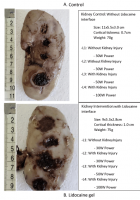Abstract
Research Article
Electrocoagulation with greased lidocaine gel 2% as hemostatic maneuver after minimally invasive partial nephrectomy: Experimental and preliminary clinical results
Marcos Tobias-Machado*, Vinicius JA Panico, Lucila H Simardi, Eliney F Faria, Rene Sotelo, Ruben Suarez, Diego Abreu, Andre Meirelles, Edison Schneider and Hamilton C Zampolli
Published: 29 April, 2020 | Volume 4 - Issue 1 | Pages: 019-023
Methods: Experimental phase: Performed a partial nephrectomy off clamp in pig model followed by cauterization of lidocaine gel 2% with different power (control, 30W, 50W and 100W) in the kidney resection bed to evaluate efficacy and deep injury extension.
Clinical phase: 20 patients submitted to laparoscopic or partial nephrectomy for low risk RENAL score were utilized greased lidocaine gel 2% with 50W in cautery scalpel to hemostasis of renal parenchima to validate efficacy and safety.
Results: Experimental study shows that this technique is effective and promote better hemostasis with 50W and 100W, with deep injury of less than 3 mm.
Clinical study confirm efficacy, good control of hemorrage, few complications and no transfusion. Minimal changes in hematocrit, haemoglobin and creatinine were observed.
Conclusion: In this preliminary experience the use of this new alternative to hemostasis for low risk partial nephrectomy was satisfactory and with good intra and postoperative results.
The best advantages were safety in terms of the depth thermal injury, low cost and absence of artifacts over the resection area observed at CT scan postoperatively.
Read Full Article HTML DOI: 10.29328/journal.acst.1001017 Cite this Article Read Full Article PDF
References
- Chen DYT, Uzzo RG. Optimal management of localized renal cell carcinoma: surgery, ablation, or active surveillance. J Natl Compr Canc Netw. 2009; 7: 635–642. PubMed: https://www.ncbi.nlm.nih.gov/pubmed/19555585
- Kunath F, Schmidt S, Krabbe L-M, Miernik A, Dahm P, et al. Partial nephrectomy versus radical nephrectomy for clinical localised renal masses. Cochrane Database Syst Rev. 2017; 5: CD012045. PubMed: https://www.ncbi.nlm.nih.gov/pubmed/28485814
- Russo P. End stage and chronic kidney disease: associations with renal cancer. Front Oncol. 2012; 2: 28. PubMed: https://www.ncbi.nlm.nih.gov/pubmed/22649783
- Kara O, Maurice MJ, Malkoc E, Ramirez D, Nelson RJ, et al. Comparison of robot-assisted and open partial nephrectomy for completely endophytic renal tumours: a single centre experience. BJU Int. 2016; 118: 946–951. PubMed: https://www.ncbi.nlm.nih.gov/pubmed/27477777
- Kutikov A, Uzzo RG. The R.E.N.A.L. nephrometry score: a comprehensive standardized system for quantitating renal tumor size, location and depth. J Urol. 2009; 182: 844–853. PubMed: https://www.ncbi.nlm.nih.gov/pubmed/19616235
- Rossaint R, Bouillon B, Cerny V, Coats TJ, Duranteau J, et al. Management of bleeding following major trauma: an updated European guideline. Crit Care. 2010; 14: R52. PubMed: https://www.ncbi.nlm.nih.gov/pubmed/20370902
- Metro MJ, McAninch JW. Surgical exploration of the injured kidney: current indications and techniques. Int Braz J Urol. 2003; 29: 98–105. PubMed: https://www.ncbi.nlm.nih.gov/pubmed/15745491
- Rosales A, Salvador J, De Graeve N, Angerri O, Villavicencio H. Clamping of the renal artery in laparoscopic partial nephrectomy: an old device for a new technique. Eur Urol. 2005; 47: 98–101. PubMed: https://www.ncbi.nlm.nih.gov/pubmed/15582256
- Abarzua-Cabezas FG, Sverrisson E, De La Cruz R, Spiess PE, Haddock P, et al. Oncological and functional outcomes of salvage renal surgery following failed primary intervention for renal cell carcinoma. Int Braz J Urol. 2015; 41: 147–154. PubMed: https://www.ncbi.nlm.nih.gov/pubmed/25928521
- Tanagho YS, Bhayani SB, Figenshau RS. Robot-assisted partial nephrectomy in contemporary practice. Front Oncol. 2012; 2: 213. PubMed: https://www.ncbi.nlm.nih.gov/pubmed/23336101
- Larcher A, Sun M, Dell’Oglio P, Trudeau V, Boehm K, et al. Mortality, morbidity and healthcare expenditures after local tumour ablation or partial nephrectomy for T1A kidney cancer. Eur J Surg Oncol. 2017; 43: 815–822. PubMed: https://www.ncbi.nlm.nih.gov/pubmed/27692535
- Tsui KH, van Ophoven A, Shvarts O, Belldegrun A. Nephron-sparing surgery for renal cell carcinoma. Rev Urol. 1999; 1: 216–225. PubMed: https://www.ncbi.nlm.nih.gov/pubmed/16985800
- de Matos Filho AS, Petroianu A, Alberti LR, Vidigal PVT, dos Reis DCF, de Souza DM. Liver hemostasis using a dry electrocautery or greased with lidocaine or neomycin or glycerin or vaseline, in rabbit. Rev Col Bras Cir. 2009; 36: 442–448. PubMed: https://www.ncbi.nlm.nih.gov/pubmed/20069158
- Petroianu A. Hemostasis of the liver, spleen, and bone achieved by electrocautery greased with lidocaine gel. Surg Today. 2011; 41: 300–302. PubMed: https://www.ncbi.nlm.nih.gov/pubmed/21264774
Figures:

Figure 1

Figure 2

Figure 3

Figure 4
Similar Articles
-
Theranostics: A Unique Concept to Nuclear MedicineLucio Mango*. Theranostics: A Unique Concept to Nuclear Medicine. . 2017 doi: 10.29328/journal.acst.1001001; 1: 001-004
-
Predictors of Candidemia infections and its associated risk of mortality among adult and pediatric cancer patients: A retrospective study in Lahore, Punjab, PakistanHafiz Muhammad Bilal*,Neelam Iqbal,Shazia Ayaz. Predictors of Candidemia infections and its associated risk of mortality among adult and pediatric cancer patients: A retrospective study in Lahore, Punjab, Pakistan. . 2018 doi: 10.29328/journal.acst.1001003; 2: 001-007
-
Endogenus toxicology: Modern physio-pathological aspects and relationship with new therapeutic strategies. An integrative discipline incorporating concepts from different research discipline like Biochemistry, Pharmacology and ToxicologyLuisetto M*,Naseer Almukhtar,Behzad Nili Ahmadabadi,Gamal Abdul Hamid,Ghulam Rasool Mashori,Kausar Rehman Khan,Farhan Ahmad Khan,Luca Cabianca. Endogenus toxicology: Modern physio-pathological aspects and relationship with new therapeutic strategies. An integrative discipline incorporating concepts from different research discipline like Biochemistry, Pharmacology and Toxicology . . 2019 doi: 10.29328/journal.acst.1001004; 3: 001-024
-
Insilico investigation of TNFSF10 signaling cascade in ovarian serous cystadenocarcinomaAsima Tayyeb*,Zafar Abbas Shah. Insilico investigation of TNFSF10 signaling cascade in ovarian serous cystadenocarcinoma. . 2019 doi: 10.29328/journal.acst.1001005; 3: 025-034
-
Fifth “dark” force completely change our understanding of the universeRobert Skopec*. Fifth “dark” force completely change our understanding of the universe. . 2019 doi: 10.29328/journal.acst.1001006; 3: 035-041
-
Risk factors of survival in breast cancerAkram Yazdani*. Risk factors of survival in breast cancer. . 2019 doi: 10.29328/journal.acst.1001007; 3: 042-044
-
Results of chemotherapy in the treatment of chronic lymphoid leukemia in Black Africa: Experience of Côte d’IvoirePacko Dieu-le-veut Saint-Cyr Sylvestre*,N’dhatz Comoe Emeraude,Kamara Ismael,Boidy Kouakou,Koffi Kouassi Gustave,Nanho Danho Clotaire,Koffi Kouassi Gustave. Results of chemotherapy in the treatment of chronic lymphoid leukemia in Black Africa: Experience of Côte d’Ivoire. . 2019 doi: 10.29328/journal.acst.1001008; 3: 045-048
-
Stercoral perforation: A rare case and reviewLava Krishna Kannappa*,Muhammad Sufian Khalid,May Hnin Lwin Ko,Mohsin Hussein,Jia Hui Choong,Ameer Omar Rawal-Pangarkar,Danaradja Armugam,Yahya Salama. Stercoral perforation: A rare case and review. . 2019 doi: 10.29328/journal.acst.1001009; 3: 049-051
-
Different optimization strategies for the optimal control of tumor growthAbd El Moniem NK*,Sweilam NH,Tharwat AA. Different optimization strategies for the optimal control of tumor growth. . 2019 doi: 10.29328/journal.acst.1001010; 3: 052-062
-
Risk factor of liver metastases in breast cancerAkram Yazdani*. Risk factor of liver metastases in breast cancer. . 2019 doi: 10.29328/journal.acst.1001011; 3: 063-065
Recently Viewed
-
Feature Processing Methods: Recent Advances and Future TrendsShiying Bai,Lufeng Bai*. Feature Processing Methods: Recent Advances and Future Trends. J Clin Med Exp Images. 2025: doi: 10.29328/journal.jcmei.1001035; 9: 010-014
-
Relationship between Vitamin D Deficiency and Lipopolysaccharides Porphyromonas gingivalis Bacteria in Stunting ChildrenErwin Gunawan*,Ria Puspitawati. Relationship between Vitamin D Deficiency and Lipopolysaccharides Porphyromonas gingivalis Bacteria in Stunting Children. Ann Biomed Sci Eng. 2024: doi: 10.29328/journal.abse.1001033; 8: 059-065
-
Addiction to self-strangulation: a case-reportAurely Ameller*,Yann Le Strat,Marion Cadranel,Celine Portalier, Caroline Dubertret. Addiction to self-strangulation: a case-report . J Addict Ther Res. 2017: doi: 10.29328/journal.jatr.1001003; 1: 016-021
-
Nanoencapsulated Extracts from Leaves of Bauhinia forficata Link: In vitro Antioxidant, Toxicogenetic, and Hypoglycemic Activity Effects in Streptozotocin-induced Diabetic MiceBárbara Verônica Cardoso de Souza, Alessandra Braga Ribeiro*, Rita de Cássia Meneses Oliveira, Julianne Viana Freire Portela, Ana Amélia de Carvalho Melo Cavalcante, Esmeralda Maria Lustosa Barros, Luís Felipe Lima Matos, Tarsia Giabardo Alves, Maria. Nanoencapsulated Extracts from Leaves of Bauhinia forficata Link: In vitro Antioxidant, Toxicogenetic, and Hypoglycemic Activity Effects in Streptozotocin-induced Diabetic Mice. Arch Pharm Pharma Sci. 2024: doi: 10.29328/journal.apps.1001063; 8: 100-115
-
Oral Suspension as Versatile Galenic Formulation in PediatryMauro Luisetto*, Almukthar N, Edbey K, Mashori GR, Fiazza C, Dona’ l, Cabianca L, Latyshev O. Oral Suspension as Versatile Galenic Formulation in Pediatry. Arch Pharm Pharma Sci. 2024: doi: 10.29328/journal.apps.1001062; 8: 091-099
Most Viewed
-
Evaluation of Biostimulants Based on Recovered Protein Hydrolysates from Animal By-products as Plant Growth EnhancersH Pérez-Aguilar*, M Lacruz-Asaro, F Arán-Ais. Evaluation of Biostimulants Based on Recovered Protein Hydrolysates from Animal By-products as Plant Growth Enhancers. J Plant Sci Phytopathol. 2023 doi: 10.29328/journal.jpsp.1001104; 7: 042-047
-
Sinonasal Myxoma Extending into the Orbit in a 4-Year Old: A Case PresentationJulian A Purrinos*, Ramzi Younis. Sinonasal Myxoma Extending into the Orbit in a 4-Year Old: A Case Presentation. Arch Case Rep. 2024 doi: 10.29328/journal.acr.1001099; 8: 075-077
-
Feasibility study of magnetic sensing for detecting single-neuron action potentialsDenis Tonini,Kai Wu,Renata Saha,Jian-Ping Wang*. Feasibility study of magnetic sensing for detecting single-neuron action potentials. Ann Biomed Sci Eng. 2022 doi: 10.29328/journal.abse.1001018; 6: 019-029
-
Pediatric Dysgerminoma: Unveiling a Rare Ovarian TumorFaten Limaiem*, Khalil Saffar, Ahmed Halouani. Pediatric Dysgerminoma: Unveiling a Rare Ovarian Tumor. Arch Case Rep. 2024 doi: 10.29328/journal.acr.1001087; 8: 010-013
-
Physical activity can change the physiological and psychological circumstances during COVID-19 pandemic: A narrative reviewKhashayar Maroufi*. Physical activity can change the physiological and psychological circumstances during COVID-19 pandemic: A narrative review. J Sports Med Ther. 2021 doi: 10.29328/journal.jsmt.1001051; 6: 001-007

HSPI: We're glad you're here. Please click "create a new Query" if you are a new visitor to our website and need further information from us.
If you are already a member of our network and need to keep track of any developments regarding a question you have already submitted, click "take me to my Query."

















































































































































